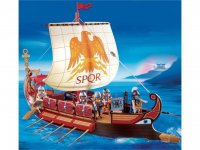JJDESIGNS - JULY 2019 PRE-ORDER
This month the first of the much anticipated Punic Warships will be available for pre-order.
Pre-Ordered items will be available with an approximate 15% discount.
PRE-ORDER PERIOD ENDS 31st JULY 2019
NO PRE-ORDERS WILL BE ACCEPTED AFTER THE 31st JULY 2019
THE PUNIC WARS- ROMAN WARSHIP
The Punic Wars were a series of three wars fought between Rome and Carthage from 264 BC to 146 BC.
At the time, they were some of the largest wars that had ever taken place.
The term Punic comes from the Latin word Punicus (or Poenicus), meaning "Carthaginian", with reference to the Carthaginians' Phoenician ancestry.
The main cause of the Punic Wars was the conflicts of interest between the existing Carthaginian Empire and the expanding Roman Republic. The Romans were initially interested in expansion via Sicily (which at that time was a cultural melting pot), part of which lay under Carthaginian control. At the start of the First Punic War (264-241 BC), Carthage was the dominant power of the Western Mediterranean, with an extensive maritime empire. Rome was a rapidly ascending power in Italy, but it lacked the naval power of Carthage.
The Second Punic War (218-201 BC) witnessed Hannibal's crossing of the Alps in 218 BC, followed by a prolonged but ultimately failed campaign of Carthage's Hannibal in mainland Italy. By the end of the Third Punic War (149-146 BC), after more than a hundred years and the loss of many hundreds of thousands of soldiers from both sides, Rome had conquered Carthage's empire, completely destroyed the city, and became the most powerful state of the Western Mediterranean.
With the end of the Macedonian Wars – which ran concurrently with the Punic Wars – and the defeat of the Seleucid King Antiochus III the Great in the Roman–Seleucid War (Treaty of Apamea, 188 BC) in the eastern sea, Rome emerged as the dominant Mediterranean power and one of the most powerful cities in classical antiquity. The Roman victories over Carthage in these wars gave Rome a preeminent status it would retain until the 5th century AD.
The Punic Wars are most remembered for the Carthaginian Hannibal's crossing of the Alps. His army invaded Italy from the north and resoundingly defeated the Roman army in several battles, but never achieved the ultimate goal of causing a political break between Rome and its allies.
While fighting Hannibal in Italy, his brother Hasdrubal in Hispania, and Sicily, Rome simultaneously fought against Macedon in the First Macedonian War.
Eventually, the war was taken to Africa, where Carthage was defeated at the Battle of Zama (201 BC) by Scipio Africanus.
The Punic Wars, is one of the most varied and colourful ancient periods. It would also not be possible to represent this period without presenting the naval war aspect of the conflict.
The Carthaginians were famed in antiquity for their seafaring skills and innovation in ship design. The empire their navy protected stretched from Sicily to the Atlantic coast of Africa. Able to match the tyrants of Sicily and the Hellenistic kingdoms Carthage’s dominance of the seas would be challenged and ultimately replaced by the Romans, who were able to create a navy that became just as successful as their land army.
Carthage took over the old Phoenician colonies in the Mediterranean and created many new ones so that its empire included North Africa, the Iberian peninsula, Sicily, Sardinia, Corsica, and many other islands. To maintain trade contacts between these cities and to police their interests the Carthaginians used a naval fleet which became the envy of the ancient world. Such was its strength that Rome, although successful in land battles, was forced to build its first ever fleet in order to defeat Carthage and claim the western Mediterranean for its own. For three centuries prior to the Punic Wars, though, the Carthaginian fleet ruled the waves.
The main aim in a naval battle was to ram and hole an enemy vessel or break its bank of oars. Sails were not used in battle conditions, but oar-power could give a ship a speed of 7-8 knots. Crews had to be well-trained to not only manoeuvre a ship as best as possible but also know when not to drive too far into an enemy ship and so become stuck when the ram impaled it. The second stage was to assault the enemy with missiles and, if necessary, board using grappling hooks and fight hand-to-hand. Polybius describes the skills and tactics of the Carthaginian navy in battle thus,
They much surpassed the Romans in speed, owing to the superior build of their ships and the better training of the rowers, as they had freely developed their line [formation] in the open sea. For if any ships found themselves hard pressed by the enemy it was easy for them, owing to their speed, to retreat safely to open water and from thence, fetching round on the ships that pursued…them, they either got in their rear or attacked them in the flank. As the enemy then had to turn around they found themselves in difficulty owing to the weight of the hulls and the poor oarsmanship of the crews, [so the Carthaginians] rammed them repeatedly and sunk many. (quoted in Salimbeti, 49)
Rome quickly realised that to defeat Carthage they would have to do what they had never done before - build their own naval fleet. Accordingly, in the spring of 260 BCE, Rome constructed a fleet of 20 triremes and 100 quinquereme warships in only 60 days. Copying the design of a captured Carthaginian ship, the Romans then added a whole new feature: the corvus (raven). This was a rotating 11-metre long platform with a giant holding spike (like a beak, hence the bird name) which could be lowered onto an enemy vessel to allow a heavy infantry unit (perhaps 80-120 men) to board them. The idea would negate the superior seamanship of the Carthaginians and make naval combat more like a land battle. This masterstroke of inventiveness was an immediate success when their fleet of 145 ships defeated the Carthaginian fleet of 130 ships at the battle of Mylae (Milazzo) in 260 BCE. The Carthaginians, so dismissive of their opponent’s seafaring skills, had not even bothered to form battle lines. When the Carthaginian flagship was captured, the commander was forced to flee in a rowing boat. The Roman commander Duilius was honoured with a Roman triumph, the first in Rome’s history to be awarded for a naval victory.
Please note that these ships are designed to represent the naval battles of the Punic wars, to create a practical display with figures, and are not accurate scale models of the ships of the period.
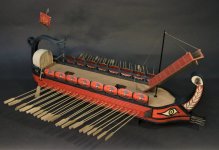
MRRWARSHIP
ARMIES AND ENEMIES OF ANCIENT ROME,
ROMAN WARSHIP,
(71pcs)
PREORDER PRICE: US$395
WARSHIP Dimensions 24” length x 16 ½” wide x 12 ½” height
WEIGHT: 6.58kg (including packaging box)
PACKAGE BOX: 27” x 16” x 9”
PRE-ORDER PERIOD ENDS 31st JULY 2019
RETAIL PRICE AFTER JULY 31st 2019: US$452
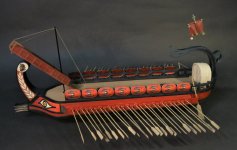
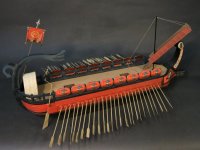
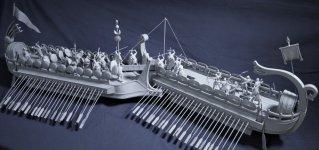
Please note figures will become available in 2020, once preorders for the Warships have been completed.
The Preorder period for the Carthaginian Warship will begin in August 2019.
PRE-ORDER PERIOD FOR THE ROMAN WARSHIP ENDS 31st JULY 2019.
This month the first of the much anticipated Punic Warships will be available for pre-order.
Pre-Ordered items will be available with an approximate 15% discount.
PRE-ORDER PERIOD ENDS 31st JULY 2019
NO PRE-ORDERS WILL BE ACCEPTED AFTER THE 31st JULY 2019
THE PUNIC WARS- ROMAN WARSHIP
The Punic Wars were a series of three wars fought between Rome and Carthage from 264 BC to 146 BC.
At the time, they were some of the largest wars that had ever taken place.
The term Punic comes from the Latin word Punicus (or Poenicus), meaning "Carthaginian", with reference to the Carthaginians' Phoenician ancestry.
The main cause of the Punic Wars was the conflicts of interest between the existing Carthaginian Empire and the expanding Roman Republic. The Romans were initially interested in expansion via Sicily (which at that time was a cultural melting pot), part of which lay under Carthaginian control. At the start of the First Punic War (264-241 BC), Carthage was the dominant power of the Western Mediterranean, with an extensive maritime empire. Rome was a rapidly ascending power in Italy, but it lacked the naval power of Carthage.
The Second Punic War (218-201 BC) witnessed Hannibal's crossing of the Alps in 218 BC, followed by a prolonged but ultimately failed campaign of Carthage's Hannibal in mainland Italy. By the end of the Third Punic War (149-146 BC), after more than a hundred years and the loss of many hundreds of thousands of soldiers from both sides, Rome had conquered Carthage's empire, completely destroyed the city, and became the most powerful state of the Western Mediterranean.
With the end of the Macedonian Wars – which ran concurrently with the Punic Wars – and the defeat of the Seleucid King Antiochus III the Great in the Roman–Seleucid War (Treaty of Apamea, 188 BC) in the eastern sea, Rome emerged as the dominant Mediterranean power and one of the most powerful cities in classical antiquity. The Roman victories over Carthage in these wars gave Rome a preeminent status it would retain until the 5th century AD.
The Punic Wars are most remembered for the Carthaginian Hannibal's crossing of the Alps. His army invaded Italy from the north and resoundingly defeated the Roman army in several battles, but never achieved the ultimate goal of causing a political break between Rome and its allies.
While fighting Hannibal in Italy, his brother Hasdrubal in Hispania, and Sicily, Rome simultaneously fought against Macedon in the First Macedonian War.
Eventually, the war was taken to Africa, where Carthage was defeated at the Battle of Zama (201 BC) by Scipio Africanus.
The Punic Wars, is one of the most varied and colourful ancient periods. It would also not be possible to represent this period without presenting the naval war aspect of the conflict.
The Carthaginians were famed in antiquity for their seafaring skills and innovation in ship design. The empire their navy protected stretched from Sicily to the Atlantic coast of Africa. Able to match the tyrants of Sicily and the Hellenistic kingdoms Carthage’s dominance of the seas would be challenged and ultimately replaced by the Romans, who were able to create a navy that became just as successful as their land army.
Carthage took over the old Phoenician colonies in the Mediterranean and created many new ones so that its empire included North Africa, the Iberian peninsula, Sicily, Sardinia, Corsica, and many other islands. To maintain trade contacts between these cities and to police their interests the Carthaginians used a naval fleet which became the envy of the ancient world. Such was its strength that Rome, although successful in land battles, was forced to build its first ever fleet in order to defeat Carthage and claim the western Mediterranean for its own. For three centuries prior to the Punic Wars, though, the Carthaginian fleet ruled the waves.
The main aim in a naval battle was to ram and hole an enemy vessel or break its bank of oars. Sails were not used in battle conditions, but oar-power could give a ship a speed of 7-8 knots. Crews had to be well-trained to not only manoeuvre a ship as best as possible but also know when not to drive too far into an enemy ship and so become stuck when the ram impaled it. The second stage was to assault the enemy with missiles and, if necessary, board using grappling hooks and fight hand-to-hand. Polybius describes the skills and tactics of the Carthaginian navy in battle thus,
They much surpassed the Romans in speed, owing to the superior build of their ships and the better training of the rowers, as they had freely developed their line [formation] in the open sea. For if any ships found themselves hard pressed by the enemy it was easy for them, owing to their speed, to retreat safely to open water and from thence, fetching round on the ships that pursued…them, they either got in their rear or attacked them in the flank. As the enemy then had to turn around they found themselves in difficulty owing to the weight of the hulls and the poor oarsmanship of the crews, [so the Carthaginians] rammed them repeatedly and sunk many. (quoted in Salimbeti, 49)
Rome quickly realised that to defeat Carthage they would have to do what they had never done before - build their own naval fleet. Accordingly, in the spring of 260 BCE, Rome constructed a fleet of 20 triremes and 100 quinquereme warships in only 60 days. Copying the design of a captured Carthaginian ship, the Romans then added a whole new feature: the corvus (raven). This was a rotating 11-metre long platform with a giant holding spike (like a beak, hence the bird name) which could be lowered onto an enemy vessel to allow a heavy infantry unit (perhaps 80-120 men) to board them. The idea would negate the superior seamanship of the Carthaginians and make naval combat more like a land battle. This masterstroke of inventiveness was an immediate success when their fleet of 145 ships defeated the Carthaginian fleet of 130 ships at the battle of Mylae (Milazzo) in 260 BCE. The Carthaginians, so dismissive of their opponent’s seafaring skills, had not even bothered to form battle lines. When the Carthaginian flagship was captured, the commander was forced to flee in a rowing boat. The Roman commander Duilius was honoured with a Roman triumph, the first in Rome’s history to be awarded for a naval victory.
Please note that these ships are designed to represent the naval battles of the Punic wars, to create a practical display with figures, and are not accurate scale models of the ships of the period.

MRRWARSHIP
ARMIES AND ENEMIES OF ANCIENT ROME,
ROMAN WARSHIP,
(71pcs)
PREORDER PRICE: US$395
WARSHIP Dimensions 24” length x 16 ½” wide x 12 ½” height
WEIGHT: 6.58kg (including packaging box)
PACKAGE BOX: 27” x 16” x 9”
PRE-ORDER PERIOD ENDS 31st JULY 2019
RETAIL PRICE AFTER JULY 31st 2019: US$452



Please note figures will become available in 2020, once preorders for the Warships have been completed.
The Preorder period for the Carthaginian Warship will begin in August 2019.
PRE-ORDER PERIOD FOR THE ROMAN WARSHIP ENDS 31st JULY 2019.



